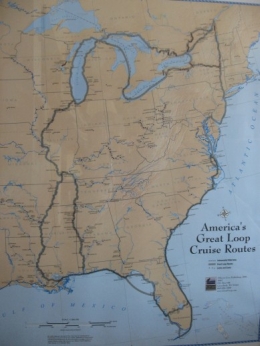After Daytona Beach, we stayed one night at a marina in Palm Coast, FL. We had planned to anchor out but there were no good options. It was a motor trip; the winds were directly out of the north. We were on the Halifax River part of the ICW until about Ormond by the Sea when it became the Matanzas River. Here is a view of one of the docks at Palm Coast from a nearby bridge. We’re the second boat from the left. The new dinghy just takes up a bit more room on the stern but we like it a lot. The ride is much more stable and much drier.
 One our way to St. Augustine, we went past Fort Matanzas, a research reserve with a lot of natural area and Rattlesnake Island. We saw a lot of dolphins along the way. The river became very winding near St. Augustine. Once at St. Augustine, we sat on the south side of The Bridge of Lions for 30 min. waiting for the opening with 5 other sailboats. The goofy bridge tender wouldn’t open because no one officially called him on the radio in time (even though he could see us all sitting there) so he made us wait until 3:30. I guess work has been going on at the bridge since 2005. Here are some of the boats going under the bridge; the lift part of it is temporary. They must have removed the decorative lions during construction as I didn’t see any.
One our way to St. Augustine, we went past Fort Matanzas, a research reserve with a lot of natural area and Rattlesnake Island. We saw a lot of dolphins along the way. The river became very winding near St. Augustine. Once at St. Augustine, we sat on the south side of The Bridge of Lions for 30 min. waiting for the opening with 5 other sailboats. The goofy bridge tender wouldn’t open because no one officially called him on the radio in time (even though he could see us all sitting there) so he made us wait until 3:30. I guess work has been going on at the bridge since 2005. Here are some of the boats going under the bridge; the lift part of it is temporary. They must have removed the decorative lions during construction as I didn’t see any.
 We anchored on the north side of the bridge in Matanzas Bay and spent three nights there. The marina charges $10/day for use of their dinghy dock and facilities. It’s a fairly calm anchorage and convenient to the marina but the best part is the great view. We’re the middle boat in this view of the anchorage. This is the view of Castillo de San Marcos at dusk. The cross you see isn't actually at the fort, it's a bit further north and marks the spot where Pedro Menendez de Aviles actually landed.
We anchored on the north side of the bridge in Matanzas Bay and spent three nights there. The marina charges $10/day for use of their dinghy dock and facilities. It’s a fairly calm anchorage and convenient to the marina but the best part is the great view. We’re the middle boat in this view of the anchorage. This is the view of Castillo de San Marcos at dusk. The cross you see isn't actually at the fort, it's a bit further north and marks the spot where Pedro Menendez de Aviles actually landed.


There’s so much history here; it was really neat to be so close to this historic site in our very own boat! St. Augustine was established in 1565 by the Spaniards and is the oldest permanent European settlement in the continental United States. The fort, Castillo de San Marcos, was completed in 1695. The fort is surprisingly long lasting; the main reason being the rather rare form of limestone the walls are made of. It's called coquina, spanish for tiny shell. It contains millions of microscopic air pockets making it compressible. When cannonballs hit the fort, they burrowed in, instead of shattering the wall. Rather like if you shot a BB gun into styrofoam.
There’s a great view from up on the gundeck. The schooner under sail is “Freedom” a charter that takes tour groups out several times a day.

 These horse-drawn carriages wait on Avenida Menendez for passengers. There were three more parked behind these two. Em’s brother Bob would have loved this. The aroma in the air was reminiscent of Mackinac Island!
These horse-drawn carriages wait on Avenida Menendez for passengers. There were three more parked behind these two. Em’s brother Bob would have loved this. The aroma in the air was reminiscent of Mackinac Island!

We took the Sunshine Bus over to Anastasia Island to tour the St. Augustine Lighthouse and Museum. We actually climbed the 219 steps (equiv. to 14 stories) to the top. My (Em’s) legs were fine going up but felt like rubber by the time we got back down. On the ride back over the bridge we had to wait while it opened for three sailboats. Kind of interesting being on the other end of that process!
Here’s the 165ft. lighthouse and a view from the top looking toward the ocean (that isn’t our anchorage). They did a fantastic job on the restoration of the lighthouse and the museum. If you're interested in more information on the lighthouse, here's their website: http://www.staugustinelighthouse.com/


We’re heading toward Jacksonville later this morning; there isn’t much of Florida left!











No comments:
Post a Comment